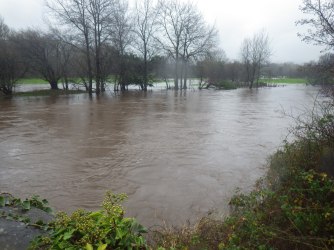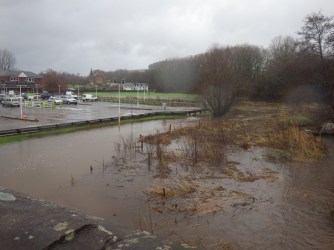
Rivers are over-topping their banks
It’s been a bit wet in the UK recently. When we compared our rainfall data for 2014 with that for this year, we saw that we’ve had approximately 50% more in November and more than 60% more in December (and it’s not quite over yet).
We are lucky in that we live on a hill and, although water flows through our garden from the field behind, it doesn’t hang around for long. In addition, our raised beds and raised chicken area act like sponges, and then drain gradually once the rain stops. Others are not so fortunate. Those living in the bottom of valleys are on the receiving end of all the water that has drained off the land further up the catchment. And so in recent days there is news of flooding in such locations.
It seems that we have suffered much more severe floods in recent years than previously and the media is keen to apportion blame… councils allowing developers to build on floodplains for example or upland livestock farming. But it’s a complicated picture and there are lots of reasons behind the current situation. Which means there isn’t a magic bullet – we can’t do one single thing to solve the problem.
Perhaps the first thing to consider is that this is about changing climate. By putting a blanket of carbon dioxide (and other greenhouse gasses) around our planet, we are trapping energy in our atmosphere. The result is the increase in storms and severe weather events. You will see many claims in the media that our changing climate is not the result of human activity. These often come from such renowned “experts” as Nigel Lawson, with his degree in Philosophy, Politics, and Economics and James Delingpole, with his degree in English Literature. If you are interested to see the credentials of those in the public eye who are sceptical about climate change, check out the DeSmog disinformation database. In contrast, the people actually undertaking scientific research about climate change overwhelmingly agree that it’s happening and that it’s anthropogenic. Indeed, according to NASA:
Multiple studies published in peer-reviewed scientific journals show that 97 percent or more of actively publishing climate scientists agree: Climate-warming trends over the past century are very likely due to human activities. In addition, most of the leading scientific organizations worldwide have issued public statements endorsing this position.
So, that’s something to bear in mind.

The local supermarket car park will soon be awash
But, back to the floods themselves… There are several things that we need to do. We need to remember that floodplains serve a particular purpose in a river catchment, and that is not providing flat land for housing! Apart from anything else, floodplains are where rivers should be able to overflow; where the water spreads out, slows down and deposits the soil particles that it’s carrying before it reaches the sea. Floodplains should be the place where we catch the fertility of the land before allowing it to be washed away, and where, as a result, we can farm productively in the drier months. Channelling water so that it moves rapidly through this part of the catchment means that the energy is not dissipated and any nutrients will disappear out to sea.
Further up river catchments we also need to slow down the movement of water. We need to develop a landscape that holds water – upland bogs and grazed diverse grasslands are good for this – and where water is intercepted by trees and shrubs. We don’t need a smooth landscape where water just flows off – we need diverse topography, with pools, banks along contours, a mixture of vegetation types and a well-developed soil. Upland woodlands slow the movement of water, from the moment it falls. Leaves, twigs and branches intercept rain and increase the time it takes for that water to reach the surface. Tree roots make the ground more permeable, and this increases infiltration. Plus, the organic nature of deciduous woodland soils means they act like a sponge and hold large amounts of water.
Anywhere in the catchment, we can make a difference to the water-holding capacity of soil. You are doing this if you add compost to the beds in your garden. In addition, any organic matter incorporated into the soil (whether in a tiny garden or on a large farm) is acting as a sink for carbon and thus reducing net greenhouse gas emissions. These are really good reasons to compost waste and to treat any organic matter as a resource not a problem to be disposed of… not to mention increasing soil fertility and therefore allowing you to grow better crops, which photosynthesise and thus also reduce carbon dioxide in the atmosphere. Another benefit, is that increasing the water-holding capacity of soils reduces the impact of droughts – something we have also encountered recently. Adding organic matter, therefore, is a win-win situation.
So, whilst we can’t stop the flooding right now, we can manage our land better to reduce problems in the future. And we can all do this – plant a tree, make compost, build a garden bed, collect rainwater to flush the toilet or water your house plants. Every action helps and together we can make a difference.

Over the banks but not over the bridge


Wild Daffodil
/ December 30, 2015Brilliant!
LikeLike
wscottling
/ December 30, 2015Our house is built on the 100 year floodplain, and we knew that when we bought it. Someone at some time cleared the land and there’s nothing but grass here for most of the 2.5 acres — which I hate BTW. This year our little town has also seen a lot of rain this past month and we’v been flooded twice right up to our porch (I’ve blogged about it both times). We’ve got big plans for this land and a little water now and again isn’t gonna stop us. I think the plans that we have will help because all of this grass is just useless really.
LikeLike
wscottling
/ December 30, 2015Sorry that wasn’t meant to be a reply!
LikeLike
katechiconi
/ December 30, 2015We have a good bit more seasonal rainfall than the UK, and flooding is a fact of life in this part of the world; too much rain descends too quickly for even the most absorbent ground to deal with. The result in this flat part of the country is widespread flooding. I continue to marvel at the local authority giving consent for housing in areas every local knows will be metres under water at the next Big One… Lots of storm drains, floodwater channels and catchment basis will not take care of it. In this climate, you build your house high off the ground if you have any sense, and take what comes.
LikeLike
The Snail of Happiness
/ December 30, 2015I am wondering when they will start building houses on stilts in the UK!
LikeLike
katechiconi
/ December 30, 2015Anyone in low lying areas should certainly consider it! Not to mention the fact that building on stumps is more ecologically responsible than laying down a huge concrete slab…
LikeLiked by 1 person
davidprosser
/ December 31, 2015I can’t understand the position of the naysayers. Precautions like you suggest would not hurt them if they’re wrong and would still enhance the world even if they’re right.(which they’re not).
The world may go through natural cycles of global warming but no-one can say that man is not helping hasten it. We should be trying to correct our mistakes of the past and prepare the world for a different future for our descendants.
Happy New Year to you both.
Hugs Galore xxx
LikeLike
The Snail of Happiness
/ December 31, 2015Happy new year David
xxx hugs xxx
LikeLike
Kitty
/ December 31, 2015Houses on stilts – yes that would be a great idea. My relations houses in New Zealand are all built on stilts. Also encouraging more people to grow hedges and trees to be planted would help a little. Nature will always have its way at some point or other though.
LikeLike
The Snail of Happiness
/ December 31, 2015And if we have raised houses, we can have ground underneath that the water can penetrate – it’s win-win
LikeLiked by 1 person
Kitty
/ December 31, 2015Indeed indeed 🙂
LikeLike
insearchofitall
/ December 31, 2015No one could have said this better. I don’t get the absurd idea of building in areas that you know are in danger of something and not building for that danger. Wood frame homes in tornado alley, slab houses in flood plains or homes not well engineered in earthquake country. I asked a lot of questions before buying my manufactured home because it is at the bottom of a hill and we have a LOT of water around here. It wasn’t near a flood plain and it is raised a foot off the ground on blocks. It also appears that they have done a good job of putting in drainage and watch closely when we get heavy rains here. I added a lot of extra roof gutters to keep the water from washing away the soil around my place. We have a lot of creeks around and almost enough trees. The bugs are eating a lot of them because it’s too warm, too long. I’ve been nurturing several saplings that are starting up to hold more ground. If we don’t all take some responsibility, we will all pay in the end. I get sick when I see clear cutting of trees. Then they wonder why we have mud slides when it rains.
LikeLike
The Snail of Happiness
/ December 31, 2015It does appear that the main thing we need is some common sense… not much of that exhibited by politicians, sadly!
LikeLiked by 1 person
insearchofitall
/ December 31, 2015Common sense is no longer common.:( In politicians, it’s bred out of them.
LikeLiked by 1 person
Lori Fontanes
/ January 2, 2016I was thinking of you guys when I heard about the flooding! We were in France for Christmas (where it was unseasonably hot–bees on flowers, birds singing spring songs) while back In the U.S., they had blizzards, tornadoes and summer heat. El Nino crossed with climate change = challenging days ahead, no doubt! Glad to hear you got through your latest episode and sending hopes that whatever flood mitigation strategies are needed will be implemented soon!
LikeLike